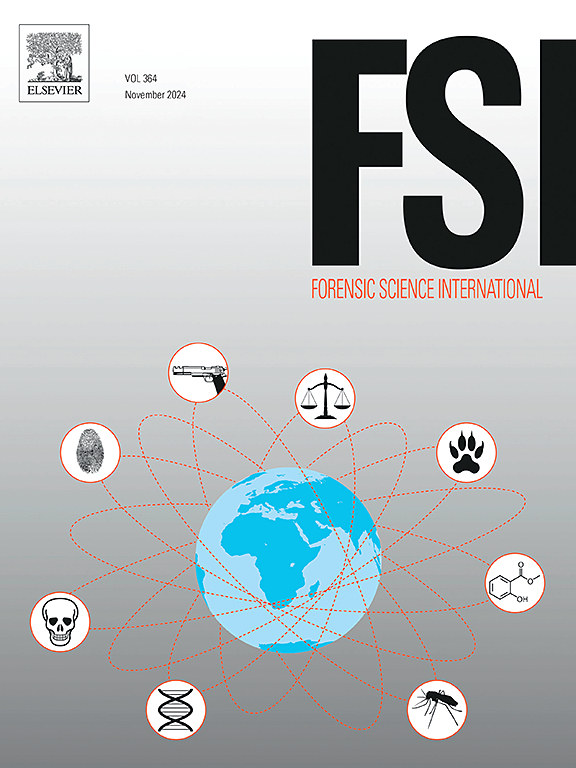从指趾镜到最小表面要求(MSR):一种评估和获得合适的人类STR剖面的度量
IF 2.2
3区 医学
Q1 MEDICINE, LEGAL
引用次数: 0
摘要
摩擦皮肤脊(指型镜)和DNA分析在几十年来的法医调查中都发挥了重要作用。在犯罪现场,同时成功地收集潜在指纹的脊纹并分别分离其人类DNA可能是一项具有挑战性的任务。最大限度地从这类物证中获得遗传信息的数量和质量已成为法医学的目标之一。通常,由于脊的视觉清晰度低和/或图案面积不足,摩擦脊印可能缺乏区分力。在这种情况下,优化人类DNA的收集和提取对于从不合适的手印中获得基因身份至关重要。最近的研究已经证明,完整的短串联重复序列(STR)图谱可以从接触DNA样本中获得。虽然已经探索了指纹增强技术对DNA恢复的影响,但尚未有研究调查了每个脊图案区域可以分离的DNA的潜在数量。本研究对DNA采集和提取方法进行了研究和优化,以确定最小脊面要求(MSR),以提取合适的人类STR基因型。12名参与者,包括生物学上的男性和女性,提供了他们的食指、中指和无名指的墨水指纹,以计算平均指尖的大小,从而创建一个“标准”区域,用于对所有捐赠者进行分析。创建了一个标准化的切割模板,以适应每个参与者在预先清洁的玻璃表面上的潜在手印。比较了两种手印“充注-沉积-收集”方法(Original Experiment和Optimized Experiment)和两种DNA采集拭子(西班牙Delta Lab的棉签和意大利Copan公司的4N6FLOQSwabs®)。然后,10名参与者沉积手印进行DNA提取,定量,STR扩增和毛细管电泳(CE)进行STR基因分型。结果表明,蜂群拭子比棉签拭子更有效地采集DNA,且优化后的采集方法能生成合适的STR图谱。本研究建立了第一个MSR表面,从中可以获得有意义的STR剖面。这些数据提供了关键的知识,帮助犯罪调查人员在检查潜在手印时优先考虑指型鉴定、基因分型或同时进行两种分析。本文章由计算机程序翻译,如有差异,请以英文原文为准。
From dactyloscopy to the Minimum Surface Requirement (MSR): a metric to assess and obtain suitable human STR profiles
Friction skin ridge (Dactyloscopy) and DNA analyses have both played an essential role in forensic investigations for decades. The simultaneous and successful collection of a latent fingermark ridge pattern and the respective isolation of its human DNA can be a challenging task at a crime scene. Maximizing the quantity and quality of genetic information from this type of physical evidence has become one of the objectives of forensic science. Often, friction ridge impressions may lack discriminatory power due to low visual clarity of ridges and/or insufficient pattern area. In such cases, an optimized human DNA collection and extraction becomes crucial for obtaining a genetic identity from an unsuitable fingermark. Recent studies have proven that complete Short Tandem Repeat (STR) profiles can be acquired from touch DNA specimens. Although the impact of fingermark enhancement techniques on DNA recovery has been explored, no research has yet investigated the potential quantity of DNA that could be isolated per area of a ridge pattern. Here, DNA collection and extraction methods to determine the Minimum ridge Surface Requirement (MSR) to extract suitable human STR genotypes have been studied and optimized. Twelve participants, including biological males and females, provided ink prints of their index, middle, and ring fingers from both hands to calculate an average fingertip size to create a “standard” area for analysis across all donors. A standardized cutout template was created to fit every participant’s latent fingermarks on pre-cleaned glass surfaces. Two fingermark “recharging-deposition-collecting” methods (i.e., Original Experiment and Optimized Experiment) and two swab types for DNA collection were compared (i.e., cotton swabs from Delta Lab (Spain) and 4N6FLOQSwabs® from Copan (Italy)). Then, ten participants deposited fingermarks for DNA extraction, quantification, STR amplification, and capillary electrophoresis (CE) for STR genotyping. Results showed that flocked swabs were more effective than cotton swabs at collecting DNA and produced suitable STR profiles with the optimized collection method. This research establishes the first MSR surfaces from which meaningful STR profiles can be acquired. These data provide key knowledge that assists crime investigators in prioritizing dactyloscopy, genotyping, or both analyses concurrently when examining latent fingermarks.
求助全文
通过发布文献求助,成功后即可免费获取论文全文。
去求助
来源期刊

Forensic science international
医学-医学:法
CiteScore
5.00
自引率
9.10%
发文量
285
审稿时长
49 days
期刊介绍:
Forensic Science International is the flagship journal in the prestigious Forensic Science International family, publishing the most innovative, cutting-edge, and influential contributions across the forensic sciences. Fields include: forensic pathology and histochemistry, chemistry, biochemistry and toxicology, biology, serology, odontology, psychiatry, anthropology, digital forensics, the physical sciences, firearms, and document examination, as well as investigations of value to public health in its broadest sense, and the important marginal area where science and medicine interact with the law.
The journal publishes:
Case Reports
Commentaries
Letters to the Editor
Original Research Papers (Regular Papers)
Rapid Communications
Review Articles
Technical Notes.
 求助内容:
求助内容: 应助结果提醒方式:
应助结果提醒方式:


